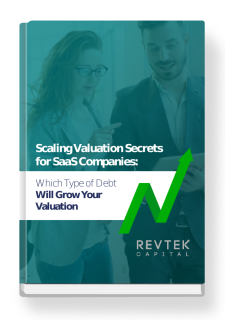Every new company has a moment where a first sale is made, cash is received, and you do a little happy dance because your dream is finally happening. All that hard work is finally paying off! For traditional businesses that provide a physical product or service as a one-time deal, such as purchasing new shoes or a software disc, cash received can go straight into the revenue account. Then, business continues as usual.
However, for SaaS businesses, specifically subscription businesses, recognizing the revenue you receive each month is a more complicated process. Everyone who starts or runs a SaaS company should be clear on correctly calculating the monthly recurring revenue. Even if you are not in charge of compiling financial statements, it is still wise to grasp how to track and designate cash received and when it can be recognized as income, which directly impacts your company’s health.
What is Revenue Recognition?
Revenue Recognition, put simply, is the idea that cash collection does not equal revenue. Revenue is only counted when the cash is earned. You must have already supplied a good or service to the customer to consider cash received as revenue. Until service is rendered, that cash is regarded as a liability, meaning a customer can request it back if they do not receive the agreed-upon service.
You can see how this could become a significant problem for a new business if cash is considered revenue and has already been spent. This is a common trap that inexperienced founders find themselves in.
Example:
Let’s say you run a subscription-based CRM website and offer plans that can be billed monthly or annually. A new customer signs up for the basic monthly plan in January and begins payment the day they sign up. They may decide they no longer need the service and ask for a full or prorated refund during that month. Therefore, that cash received is not considered revenue until they are billed in February after you have fulfilled a month of service.
This same principle applies to annually-based subscription plans. A new customer signs up for an annual plan and pays the full amount upfront. Each month, once service is rendered and obligations in the contract are fulfilled, that plan’s monthly cost is allocated as revenue.
The remainder they have already paid in advance is called deferred revenue. This deferred revenue account is kept separately from recognized revenue.
History of Software Revenue Recognition
Because software as a service, especially internet-based, is such a new business model, there are many new guidelines and rules for financial reporting. Typically, the Financial Accounting Service Board has required that software companies give customers the right to take possession of the software and run it on their hardware to be considered a rendered service.
But for SaaS, the whole point is that you host the service for them, meaning SaaS companies could not fulfill this generally accepted accounting principle (GAAP). Therefore, the FASB adopted official guidelines that fill the gap for Recognizing Revenue in the SaaS market.
5 Step Model for SaaS Revenue Recognition
- Identify the Contract With a Customer
This is straightforwardly recognized when customers sign up for a subscription or purchase a service with terms and conditions, or a service is explicitly laid out in the written or oral form.
- Identify the Performance Obligations
Performance Obligations are all of the services or benefits a customer will receive in the contract. These must be distinctly outlined and separated in the agreement.
- Determine the Transaction Price
This is the amount expected to be received for all services rendered.
- Allocate the Transaction Price
This accounts for how all services are accounted for individually as if they are stand-alone services.
- Recognize Revenue
Revenue is then recognized in monthly financial statements over a period of time as the customer receives the services allocated by the specific obligations.
In summary, you enter into a contract with a customer by laying out each expected service. By identifying the price for each of these services as they are delivered, your financials can precisely track all services rendered, and revenue recognition can occur.
Complications & Scenarios
Once you have a basic understanding of how future revenue is recognized, the principle is very straightforward. Yet, there are many scenarios where complications may arise when calculating revenue recognition for SaaS companies.
- A customer decides to upgrade or downgrade from a monthly plan to an annual plan
- One-time services are offered with a fee, such as initial set up
- Additional offers are available outside of a monthly plan, such as tech support or mentoring
Any of these cases may involve instant revenue or deferred revenue. It is essential to have a financial team that understands the accounting of each scenario. Most importantly, it is crucial to know the value of each of these offerings and whether they should be included in a package or offered as a stand-alone service.
You do not want to spend cash immediately that should be considered deferred, and you do not wish to provide a service inside a package that may generate more revenue if offered outside a standard plan.
The takeaway is that how revenue is recognized is a critical point to consider when deciding what services and add-ons are offered in your SaaS business.
Revenue Recognition & Financing
So, how does Revenue Recognition tie into your capital needs? At RevTek Capital, we desire to see our partnerships and SaaS startups thrive! We hope to offer these bits of advice, guidance, and more to help you think through business needs in the beginning stages. Or as an encouragement to solidify that you are already on the right track.
Your Recognized Revenue directly determines your Monthly Recurring Revenue. Your MRR directly determines your ability to secure capital to take your business to the next level.
Providing Capital for SaaS Company Growth with RevTek Capital
RevTek Capital provides strategic debt funding of $3MM to $30MM to innovative companies with $7MM to $75MM of predictable annual recurring revenue. The funding is used for sales growth, acquisitions, and enhancing infrastructure for scaling operations. Each company’s debt structure is customized to optimize its unique accomplishments and circumstances.
Many startup companies struggle to raise capital and have found the process to be quite time-consuming. Our organization has unique insights regarding SaaS businesses and the challenges these and other tech-enabled companies encounter. In addition, the professional team at RevTek has many years of experience in marketing and operations that may assist our clients.
Key Benefit Summary
- Cost-effective capital for growing tech-enabled companies
- The company leadership retains control
- Recurring revenues serve as the collateral for financing
- Repayment is structured into simple and manageable monthly payments
- You have faster access to funding – closing in as little as four weeks
We look forward to the opportunity to partner in growing your business!
Contact us Today!



